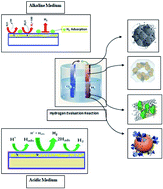Recent advances in the metal–organic framework-based electrocatalysts for the hydrogen evolution reaction in water splitting: a review
Abstract
Water splitting is an important technology for alternative and sustainable energy storage, and a way for the production of hydrogen without generating pollution. In recent years, metal–organic frameworks (MOFs) have become the most capable multifunctional resources because of their high surface areas, tunable porosity, simple modification of compositions, and potential for use as precursors with a variety of morphological structures. Based on these qualities, many MOFs and their derived materials are utilized as electrocatalysts for the water splitting reaction. Herein, we assembled the relevant literature in recent years about MOF and MOF-derived materials for their eminent electrocatalytic activity in water splitting with useful strategies for the design and preparation of catalysts, along with challenges. This review summarizes the advancement in MOF materials, elucidating different strategies for its role in water splitting.

- This article is part of the themed collection: 2021 Reviews in RSC Advances


 Please wait while we load your content...
Please wait while we load your content...